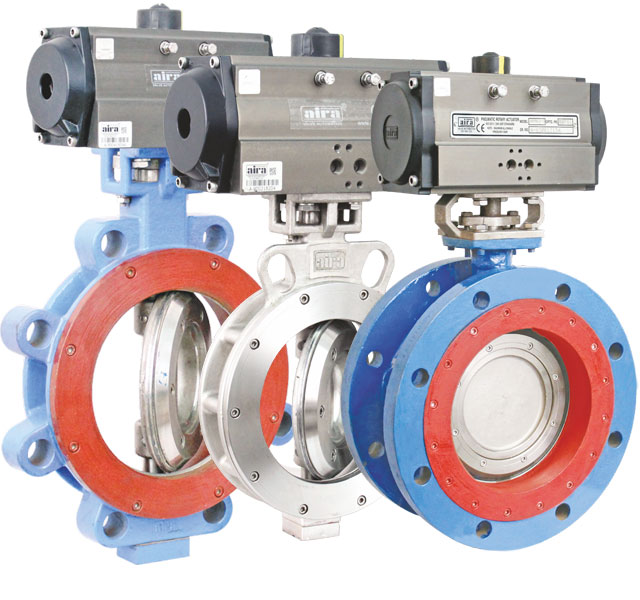Triple Offset Butterfly Valve
Design
The Triple Offset Butterfly Valves are designed and manufactured under API 609 category “B”/ BS – EN – 593.
Size Range
The Triple Offset Butterfly Valves are available in 1.1/2″ to 48″ inch size and above 48″ inch also available on request.
Body
The WCB / CF8 / CF8M / CF3M casting materials are used in making of Triple Offset Butterfly Valve Body.
Disc
The Disc in Triple Offset Butterfly Valve is made from WCB / CF8 / CF8M / CF3M materials.
Seat
The seat is available in NBR, EPDM, Viton, PTFE, RPTFE, TFM, and S.S. 304 materials.
Temperature
For NBR: -10°C to +90°C / EPDM: -10°C to +120°C / Viton: -10°C to +220°C / PTFE: -10°C to +180°C / RPTFE: -10°C to +220°C / TFM: -10°C to 250°C / S.S. 304+Graphoil Laminated: 400°C / S.S. 304+Inconel 625 Graphite Laminated +400°C
Pressure
Triple Offset Butterfly Valves comes up with 150# PN 10 / PN 16 / PN 20 & 300# PN 25 / PN 40 pressure rating and it can be increased to 600# on request.
End Connection
The Triple Offset Butterfly Valves are available in Wafer type, Lug Type, and Flanged End connections.
Inspection & Testing
FCI – 70-2 / B16, 104 / ISO 5208 / BS EN 12266-1
Leakage Class
The Triple Offset Butterfly Valves are available in leakage class IV / V / VI.
Triple Offset Butterfly Valves
Triple offset butterfly valves also known as triple eccentric valves were originally designed for water shut-off applications but now have evolved into various other industries and have proved its performance in the harshest conditions. In recent times they are also playing an important role in controlling fugitive emissions. Valve manufacturers have started focusing on Triple Offset Valves and they are now used in ways never seen before while also being used more cost effectively.
As the name says, the triple offset butterfly valve has three offsets. They are placed in a position as follows:
- 1st offset: The axis of the shaft is behind the centreline of the sealing point of the disc to the seat.
- 2nd offset: The axis of the shaft is eccentric to the center of the valve/pipeline.
- 3rd offset: It is the geometry of the seating surface, creating a type of cone shape of the disc and seat.
This cone angle, along with the two eccentric shaft offsets, allows the disc to seal against the seat with no friction. The optimized seat angle minimizes sticking or binding of the disc and lowers valve operating torque. The seat design also allows for uniform sealing, and thus a tight shutoff in a metal seat design.
Advantages
Triple Offset Butterfly Valves offer several advantages compared to other valves typically used in most upstream applications.
- For the harsh conditions of critical process applications, steam isolation and temperature extremes, Triple Offset Butterfly Valves provide performance reliability and quality.
- The bi-directional zero leakage closure with a metal seat, even after extensive cycling, provides sealing integrity formerly associated only with soft-seated valves.
- Low torque from quarter-turn action permits smaller actuators and lower cost.
- The Triple Offset Butterfly Valve is inherently fire safe with a non-rubbing rotation and fire-tested designs per API 607, 5th Edition/ISO 10497-5 are available.
- Its Compact design makes the installation easier since the valves are lighter and require less pipe bracing.
- Triple Offset Butterfly Valves can provide reductions in weight and space and substantial cost savings
Applications
The Triple Offset Butterfly Valves are used where a metal seat is required, and tight shutoff and/or quarter turn actuation is desired. Following are some industries where Triple Offset Butterfly Valves are used majorly:
- Oil & Gas
- Energy & Power
- Water and Wastewater Treatment
- Chemicals
- Food & Beverages
- Pharmaceutical & Healthcare
- Metals and Mining
- Building & Construction
- Paper and Pulp
- Others
AIRA EURO AUTOMATION duly manufactures its Triple Offset Butterfly valves by using high quality graded materials while promising total in-house manufacturing and testing of the product, hence boasting of a quantitative as well as a qualitative production.


![pdf-download[1] pdf-download[1]](https://www.tripleofsetbutterflyvalve.com/wp-content/uploads/2021/04/pdf-download1-1-1-200x200.jpg)